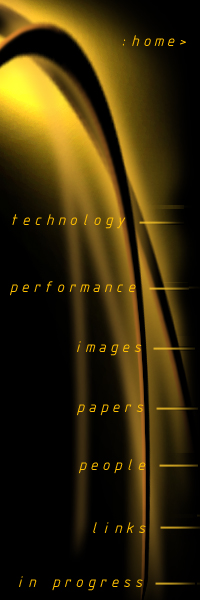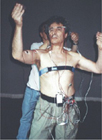
t e c h n o l o g y
About
"Body Automatic/cyberPRINT"
The cyberPRINT obtains its raw material from non-invasive and integrated
medical sensors registering vital signs in real time in numerical data
format. The BioRadio 110 is a lightweight programmable wireless physiological
monitor for measuring and recording EEG, ECG, EMG, EOG, and PSG signals.
By eliminating the restrictions encountered with traditional tethered
equipment, the BioRadio allows the individual being monitored the freedom
to move about naturally, something essential for the type of performance
required by the project. It sends the measured data via radio signals
directly to a PC, where is then processed to generate a virtual body architecture
according to design prescriptions. The necessary technology to make all
this work was developed by a team from Architecture, Medicine, Bio-Engineering
and Computer Science.
The
BioRadio 110 is used to collect data input registers the activity of three
physiologic functions historically associated with human life (1) Respiratory
and muscle activity; (2) Cardiac activity; the heart and its functions;
and (3) Nervous activity; the brain and its workings. Since physiological
data can be represented in any way within digital space, the focus of
our work was in the design of the visual-temporal prescriptions guiding
the transformation of the incoming data into visualizable 3D representations
of the three functions described:
1. New aesthetic conventions, rules, and techniques for visualizing
the body and the self in digital space (i.e., syntax and vocabulary);
2. The relationship between design intentions, and the expectations
of the performer and audience (i.e., the world of meaning: semantics);
3. How to employ and develop a design to elicit aesthetic responses
(i.e., pragmatics/content).
The project heavily draws from an area of architectural knowledge called "Basic Design". This specialty area consist of basic principles (e.g., scale, shape, rhythm, balance, color, tectonics, structure, etc.), elements (e.g., line, figures, objects, space, etc.) and organizational rules (e.g., hierarchy, layering, typology, symmetry, etc.) of 2D and 3D design and their relationship to human psychology and behavior.

